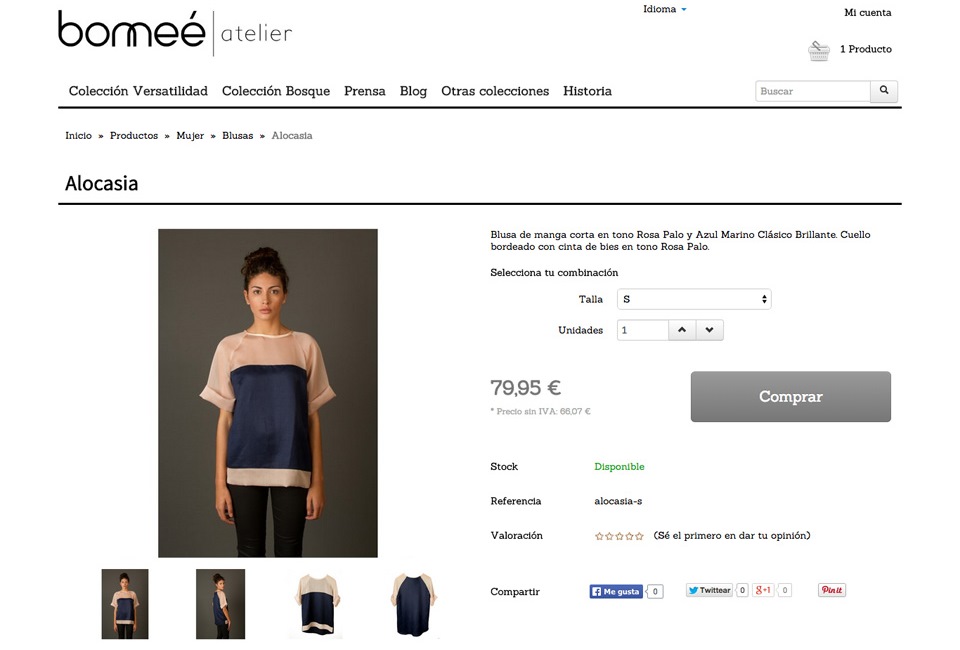Written by Fernando Maciá
Índice
The process of creating an online store is not complex. This is why we sometimes neglect small details that are extremely important when it comes to getting our store up and running. All e-commerce sites follow the same structure, but not all of them have the same functionalities implemented. Taking care of some aspects we will achieve that the user’s experience on our website is full and satisfactory.
A satisfied customer is the best advertising you can have.
What we must NOT forget when creating our online store
1. The perfect product sheet
All e-commerce stores have product cards through which we make our products known to the users who visit our store. The file must be very attractive and contain complete and relevant information, as it will be the springboard to encourage the purchase. Every product sheet should have:
- Title including the name of the product: Give a brief description of the product. Search Google’s Keyword Planner for search trends among users, this will help you in your selection.
- Price: Of course! One of the most important facts. Make it large enough so that it can be read without difficulty. It is one of the main data that the user looks at after finding your product.
- Description: In this section you should define the main characteristics of the product. Take the opportunity to include the keyword several times. It will help you to position yourself and opt for the first positions in Google. You must try to make this text attractive, in such a way that it incites to make the purchase.
- Photos: Photos from when our grandparents were young are not valid. Images should be of considerable quality, look good and be attractive to the viewer. It includes several photos of the product from different perspectives.
- User comments: What for? You ask! Well, it turns out that reviews are often one of the main factors influencing the final purchase decision. If the potential customer has doubts and reads positive comments from other users about the product, the purchase will probably be made. In addition, comments can also serve as a means to solve doubts, without having to contact the store manager.
- Social network icons: In this way we will be able to give diffusion to our products. If someone has liked something from our store and wants to share it with their friends, our content will spread, we will reach more people and we will have the possibility of generating a higher volume of sales.
- Option to select the desired units: This is something very obvious at first glance but that we often do not take into account. Maybe the user who accesses our online store wants to buy two units of X product because he wants to give one to his mother and one to his sister. It is very inconvenient to have to make the same purchase twice. Whenever you can, make it easy for the user and prevent them from leaving your store.
- Visible purchase button: Unattractive, small and barely visible buttons are useless. How about opting for a button large enough to catch the user’s attention and in a color that invites them to click? But don’t put a button that takes up the whole page or a bright yellow color that is impossible to see with the naked eye.
2. Different means of payment
It is highly recommended that your online store has several payment systems. The user who enters your online store and does not find this service adapted to their needs, will abandon the purchase right at the last step of the payment gateway, thus losing a possible sale. Ideally, at least three payment options should be available so that the customer has a choice. We recommend the following: PayPal, bank transfer, cash on delivery and TPV (credit card).
It is of no use to the user that you can only pay with PayPal if you do not have an account on this platform. We have to make it as easy as possible for you so that you do not encounter any impediment during the process and end up finalizing the purchase.
3. Transportation prices
There are data that users demand when they decide to make a certain purchase and one of them is the price of transporting the product. It does not cost us anything to add a small reference in which we talk about it. This information is very valuable to the customer. If the user is not sure what the shipping cost will be or has to send an email to ask (be sure that he will not waste time on this), he will end up not making the purchase, that is, he will leave our online store without purchasing any product, which means that we will be losing potential sales and future customers.
4. Responsive design
Your online store should have a responsive design. What is this? The website must be adapted to the size of the device used by the user to make the query: Smartphones, tablets, netbooks or desktops.
It is very uncomfortable to access an online store that does not have an adapted design, because it forces you to drag and zoom the content you want to see, since not everything is displayed on the screen. This often encourages abandonment of the page, thus generating a high bounce rate.
In addition, Google rewards those portals, websites, blogs and online stores that have a responsive design, placing them in better positions than those who have not taken into account this aspect.
Displaying a list with “Similar products”, “Recommended products” or “Similar products ” can lead to new purchases and therefore more sales in your online store. If the user is looking at dresses and right underneath they are shown shoes with which they can match it, there is a high probability that they will click on the link to get more information and that this will directly generate a new purchase.
6. Telephone or e-mail contact
Data such as telephone or e-mail contact should not be missing in your online store. The customer may have questions about something related to the product and want to consult with you. Therefore, these data must be in a visible place on the website. The user should find them easily.
If a future customer accesses your online store, moved by the interest of acquiring one of the products you offer, but has doubts about specific details, he will look for an email or a phone number to contact you. If he has to go around the web twice (which he will not do, unless he is very interested in the product), he will give up and you will have immediately lost a possible sale and a potential customer. Don’t forget that today’s consumers value their time. They are busy people who don’t like to waste time, much less on these things.
7. Blog
Take care of the contents of your online store. The blog is a way to tell your users that you know what you are talking about. Describe your products, talk about how wonderful they are, tell them how they can use them… It’s a way to keep selling yourself, while showing that you know what you’re talking about. How? What you hear. If you are a clothing store, why not talk about the last fashion show you were a guest at in Madrid? It is a way to tell them that you know the sector in which you move and in this way you will generate confidence in them and achieve possible purchases.
Don’t forget that the easier you make it for your customers, the better. They want to get in, buy, but without making life too complicated. The Internet offers you numerous possibilities, so if they don’t find what they are looking for in your store, they will visit your competitors. Making use of all these elements will make your online store complete and sufficiently attractive to users.


